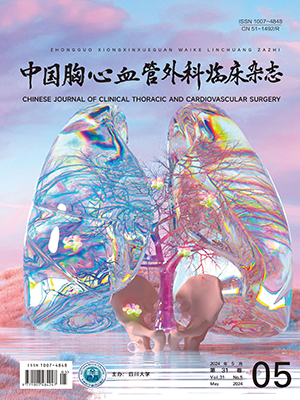Abstract: Objective To determine the risk factors for acute kidney injury (AKI) after thoracic aortic arch replacement surgery under deep hypothermic circulatory arrest (DHCA). Methods We retrospectively analyzed the clinical data of 139 patients who underwent thoracic aortic arch replacement surgery under DHCA between January 2004 and December 2008 in Beijing Anzhen Hospital Affiliated to Capital University of Medical Sciences. The patients were divided into two gro-ups according to whether AKI occurred after thoracic aortic arch replacement surgery. In the AKI gro-up (n=48), there were 39 males and 9 females with an age of 57.67±9.56 years. In the normal renal function gro-up (n=91), there were 69 males and 22 females with an age of 41.30±13.37 years. We observed the clinical data of the patients in both gro-ups, including left ventricular ejecting fraction (LVEF) before operation, diameter of the left ventricle, diameter of the ascending aorta, renal function, cardiopulmonary bypass time, aortic crossclamp time, and DHCA time. The risk factors for AKI and death after operation were evaluated by univariate analysis and stepwise logistic regression analysis. Results Among all the patients, AKI occurred in 48 (34.53%), 17 (12.23%) of whom underwent continuous renal replacement therapy (CRRT). Respiratory failure occurred in 27 patients (19.42%). Twentynine patients (20.86%) had cerebral complications, including temporary cerebral dysfunction in 26 patients and permanent cerebral dysfunction in 3 patients. In all the patients, 14 (10.07%) died, including 4 patients of heart failure, 9 patients of multiple organ failure, and 1 patient of cerebral infarction. There were 3 (3.30%)deaths in the normal renal function gro-up and 11 (22.92%) deaths in the AKI gro-up with a significant difference of mortality rate between the two gro-ups (P=0.011). A total of 118 patients were followed -up and 7 were lost. The follow-up time was from 5 to 56 months with an average time of 42 months. During the follow-up period, 7 patients died, including 3 patients of heart failure, 2 patients of cerebral apoplexy, and 2 patients of unknown reasons. The logistic regression analysis revealed that creatinine level was greater than 13260 μmol/L before operation (OR=1.042, P=0.021) and respiratory failure (OR=2.057, P=0.002) were independent determinants for AKI after the operation. Conclusion AKI is the most common complication of thoracic aortic arch replacement surgery under DHCA, and is the risk factor of mortality after the surgery. It is important to enhance perioperative protection of the renal function.
Citation: YANG Yong,LI Xiaomi,LI Fei,et al .. Analysis of Risk Factors for Acute Kidney Injury after Aortic Arch Replacement Surgery. Chinese Journal of Clinical Thoracic and Cardiovascular Surgery, 2011, 18(2): 109-113. doi: Copy




